Amplitude Modulation is defined as the process in which the peak amplitude of the carrier is varied according to the message signal. Assume the message signal and carrier are applied to a modulator to generate the amplitude modulation signal.
Table of Contents
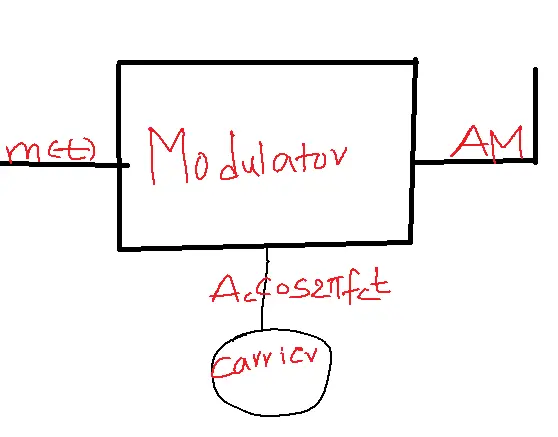
The time domain equation of the Amplitude Modulation signal is
s(t)=ACcos2πfct+AcKam(t)cos2πfct
ACcos2πfct-carrier
AcKam(t)cos2πfct – modulated signal
Ka=Amplitude sensitivity of Modulator.
In Amplitude Modulation, the carrier is transmitted along with the modulated signal used at the receiver for demodulation.
S(t)=Ac[1+Kam(t)]cos2πfct → standard form
The peak amplitude of the carrier before modulation is AC and after modulation is AC[1+Kam(t)]
If m(t) is zero, the carrier is not modulated.
The frequency domain equation of the amplitude modulation signal is

SPECTRUM
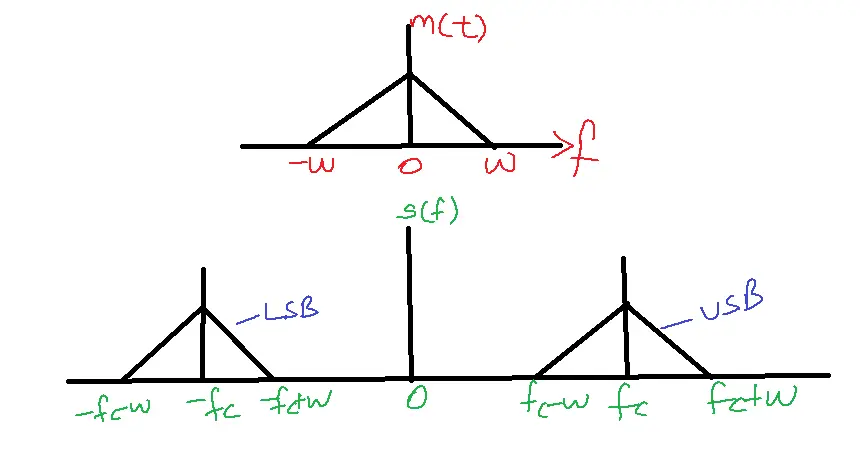
Bandwidth = fH-fL
=(fc+w)-(fc-w) = 2w
The Amplitude Modulation spectrum consists of the following frequencies:
1. Carrier frequency(fc)
2. The frequencies above fc are called upper-side band frequencies. So upper side band(USB)frequencies are fc to fc+w.
3. The frequencies below fc are called lower sideband frequencies. So fc-w to fc are low sideband (LSB) frequencies.
Single-toned Modulation of Amplitude Modulation:
If the message signal is characterized by a single frequency, the resulting modulation is termed single-tone modulation. In the case of single-toned modulation, the message is the sinusoidal signal.

The time domain equation of the Amplitude Modulation(AM) signal is
S(t)=Accos2πfct+AcKaAmcos2πfmtcos2πfct
, itKaAm=µ=m=modulation index or depth of modulation
Practically, the transmission modification index lies between 0 and 1.
The modulation index concept is required to demodulate the amplitude modulation signals using an envelope detector.
If µ=0 the carrier is not modulated.
S(t)= Ac[1+µcos2πfmt]cos2πfct

The Bandwidth of the modulated signal depends only on the highest frequency of the message signal.
Example: If the message is an audio signal the bandwidth of the Amplitude Modulation(AM) signal is 40 KHz.
Power calculations:
P=Vrms2/R where R is the antenna resistance
If R=1 ohm, the power is called Normalised Power.
The Carrier Power Pc=Ac2/2R
PUSB=PLSB
Lower sideband Power = Upper side band Power
The total power radiated into free space is
Pt= Pc +PUSB +PLSB

Modulation efficiency is determined by calculating the ratio of sideband power to the total transmitted power.
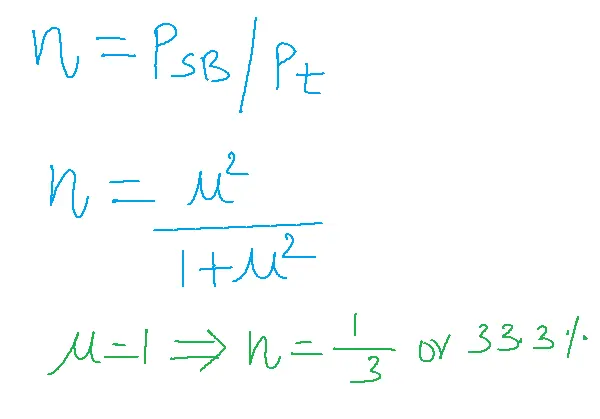
Efficiency indicates the side band Power. In Amplitude modulation, the maximum efficiency possible is only 33 percent.
The maximum sideband power is only 33 percent. So, the amplitude modulation carrier takes more power, and sideband power takes less power.
In amplitude, modulation receivers ‘ noise ratio depends only on sideband power and does not depend on the carrier power.
Example: An AM Transmitter, when modulated by a sinusoidal signal with a modulation index of 0.707, radiates 50W. Determine efficiency, sideband power, and carrier power. Determine the peak amplitude of the carrier before modulation and after modulation.
Solution: efficiency = 20%[Apply efficiency formula]
PSB=10W[20% of Pt]
PC=0.8 X 50 = 40W
The time domain equation of the modulated signal is
Ac=[1+µ cos2πfmt]cos2πfct
The peak amplitude after modulation changes concerning time
Vmax=Ac[1+µ]=9[1+0.707]=15.36
Vmin=Ac[1-µ]=9[1-0.707]=2.637
Amplitude Modulation Waveforms:
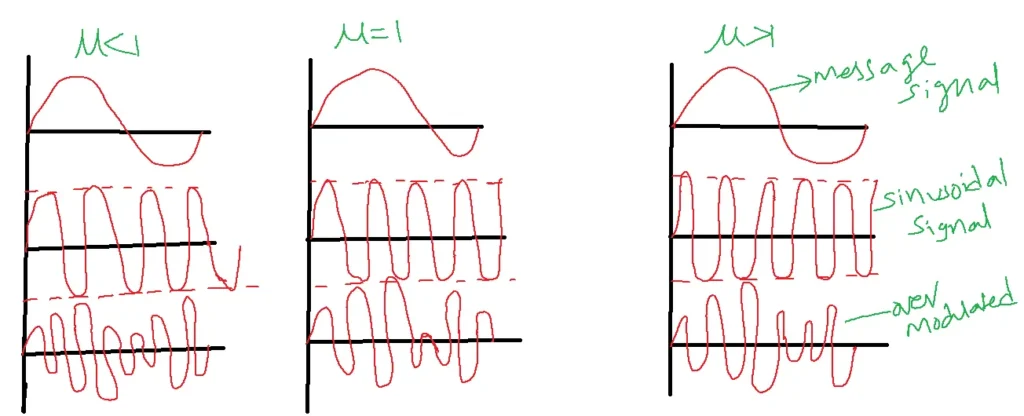
If µ=0, the carrier is not modulated.
If µ≤1, the amplitude of the AM signal is the same as the message.
If µ>1, the amplitude of the AM signal is not the same as the message. An AM signal is said to be over-modulated. Demodulation is not possible in this case.
Antenna Current:
Consider an antenna having resistance R ohms. Assume that the AM signal is transmitted into free space.
It is the antenna current when the AM signal is radiated.
The total power radiated into free space is
Ic is the antenna current before modulation and It is the antenna current after modulation.
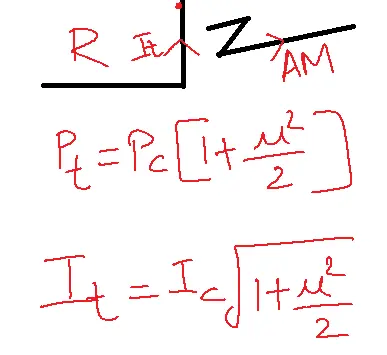
Generation of Amplitude Modulation Signals:
The two fundamental techniques used for generating Amplitude Modulation signals are
1. Square Law Modulator
2. Switching Modulator
Demodulation of Amplitude Modulation Signals:
The objective of demodulation is to get back the message signal from the modulated signal or to convert the high-frequency signal into a low-frequency signal.
The following two methods used for AM Demodulation are
1. Square law demodulator
2. Envelope detector
Applications of Amplitude Modulation
- AM Radio Broadcasting: The foundation of traditional radio broadcasting, enabling the transmission of voice and music over long distances.
- Airband Radio: Used for communication between pilots and air traffic controllers, ensuring safe and efficient air travel.
- Amateur Radio: Popular among hobbyists for voice and data communication, fostering a global community of radio enthusiasts.
- Single Sideband (SSB) Communication: A variation of AM used for long-distance voice communication, offering improved power efficiency and reduced bandwidth requirements.
- Quadrature Amplitude Modulation (QAM): A combination of amplitude and phase modulation in digital communication systems like Wi-Fi and cable modems, allowing for higher data rates.
- Medical Imaging: AM is employed in certain types of medical imaging equipment, such as ultrasound scanners, to visualize internal organs and tissues.
- Industrial Control: Industrial Control: AM signals are employed in various industrial applications, including motor control, distance measurement, and object detection.
- Aircraft Communication: AM is utilized in aircraft communication systems for voice and navigation signals, ensuring safe and reliable flight operations.
- Experimental Physics: Researchers employ AM in experiments involving particle accelerators, spectroscopy, and other scientific instruments.
- Remote Sensing: AM is leveraged in remote sensing technologies like radar and lidar to gather information about the Earth’s surface and atmosphere.
FAQs related to the topic
Q1. What is amplitude modulation (AM), and how does it work?
- Amplitude modulation (AM) is a technique that modifies the strength of a carrier wave to match the variations in the information-carrying signal. It’s the foundation of traditional radio broadcasting.
Q2. What are the different types of amplitude modulation?
- There are several types, including Double Sideband Full Carrier (DSB-FC), Double Sideband Suppressed Carrier (DSB-SC), Single Sideband (SSB), and Vestigial Sideband (VSB), each with unique characteristics and applications.
Q3. What are the advantages and disadvantages of amplitude modulation?
- AM is simple to implement and demodulate, making it suitable for long-distance transmission. However, it’s prone to noise and interference, and its power efficiency isn’t optimal.
Q4. How is amplitude modulation used in radio broadcasting?
- AM radio stations transmit audio signals by modulating the amplitude of a carrier wave. Receivers then demodulate the signal to recover the original audio.
Q5. What is the modulation index in AM, and why is it important?
- The modulation index measures the extent to which the message signal modulates the carrier wave.
- It determines the quality and efficiency of the transmission, with higher values generally resulting in better audio quality but increased bandwidth requirements.
